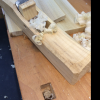Hi, all -
I'm cleaning up a 5C to add to the arsenal, which I thought was a Type 11, but I decided to verify that and now I know it's not an 11, but I can't tell if it's an 8 or a 9. It's a Bailey #5C, shown below:
5C pic 1.jpg
According to the identification page I'm using, the 2 patent dates behind the frog and the straight frog rib make this a type 9. However, the lateral adjustment lever has a single date on it:
5C pic 3.jpg
According to the same page, that makes this a type 8 lateral lever. I know it can't be a type 10, since the frog rib isn't arched, and I don't think it's an 8, since the page describes the frogs/receivers as "flat with 2 grooves" and this one is has a rib, but no adjustment screw. Plus, a type 8 should have a "B" foundry mark behind the frog, and this one doesn't. (There's a "B" on the back of the lever cap, though, which is otherwise unmarked and has rounded edges.) My confusion, basically, is that everything screams this is a type 9, but there's a date on the lateral adjustment lever, and according to that page, the 9s had no date on the lever. What am I missing?
To further confuse things, the iron is stamped at the top with, "STANLEY" and "PAT. APL 19 92" and the cap iron is stamped with "L.BAILEY'S PATENT DEC.24.1867"
daniel





 Reply With Quote
Reply With Quote




